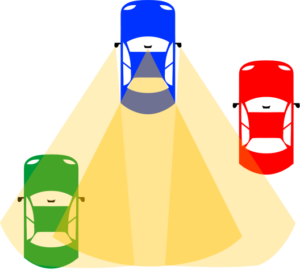Spatial Awareness While Driving
Written By | Doreen Almirol | 20+ years CA DMV Licensed Driving Instructor
Spatial awareness is a fundamental skill that every driver must possess to navigate the roads safely. It involves the ability to accurately judge the position and movement of your vehicle in relation to other objects and vehicles around you. Whether you’re a new driver or have years of experience, enhancing your spatial awareness can significantly reduce the risk of accidents and improve your driving confidence. In this article, we’ll explore how to judge spatial awareness when driving and provide tips to sharpen this essential skill.
This blog may contain affiliate links, and if you make a purchase through these links, we may or may not earn a commission at no extra cost to you.
1 | Maintain a Safe Following Distance
One of the first steps in judging spatial awareness is maintaining a safe following distance. Keep a sufficient gap between your vehicle and the one in front of you, which gives you time to react if the leading vehicle brakes suddenly. The recommended following distance is typically 1 car length distance for every 10 mph your car is traveling, but it may vary depending on road conditions.
LEARN MORE: The Art of Defensive Driving | Safe Spacing
2 | Use Your Mirrors Effectively
Your side and rearview mirrors are invaluable tools for assessing spatial awareness. Adjust them correctly to cover blind spots and maximize your view of surrounding traffic. Regularly check your mirrors to monitor the position and speed of vehicles behind and beside you.
LEARN MORE: Proper MIRROR Adjustment and Usage for Safe Driving
3 | Stay Centered in Your Lane
Maintain a centered position within your lane to ensure adequate space on both sides of your vehicle. This positioning allows for better maneuverability and minimizes the risk of brushing against obstacles, curbs, or other vehicles.
4 | Pay Attention to Road Signs and Markings
Road signs, lane markings, and signals provide critical information for judging spatial awareness. Follow these cues to make informed decisions about your vehicle’s position and movements. For example, yield signs indicate when you need to yield to other vehicles, while lane markings dictate where your vehicle should be positioned.
LEARN MORE: Traffic Laws & Regulations
5 | Be Mindful of Blind Spots
Every vehicle has blind spots—areas around your car that are not visible in your mirrors. Make a habit of checking your blind spots by turning your head and using shoulder checks when changing lanes or merging.
In the image below, the RED car is in the BLUE car’s blind spot. The driver of the BLUE car will need to turn their head towards the right side windows to see the RED car.
6 | Stay Calm and Focused
Emotions and distractions can impair your spatial awareness. Stay calm, focused, and alert while driving. Avoid using your phone, eating, or engaging in activities that divert your attention from the road.
LEARN MORE: A Guide to Avoiding Distracted Driving
Mastering spatial awareness when driving is vital for your safety and the safety of others on the road. By following these tips and continuously honing your skills, you can become a more confident and responsible driver. Always remember that good spatial awareness can help prevent accidents and ensure a smooth and stress-free driving experience.
Ready to Drive with Confidence?
Struggling with spatial awareness? Sign up for driving lessons today! Expert guidance, personalized tips, and structured practice will boost your confidence behind the wheel.
Don’t let challenges hold you back—take control of your driving journey now. Sign up and conquer the road with ease!


